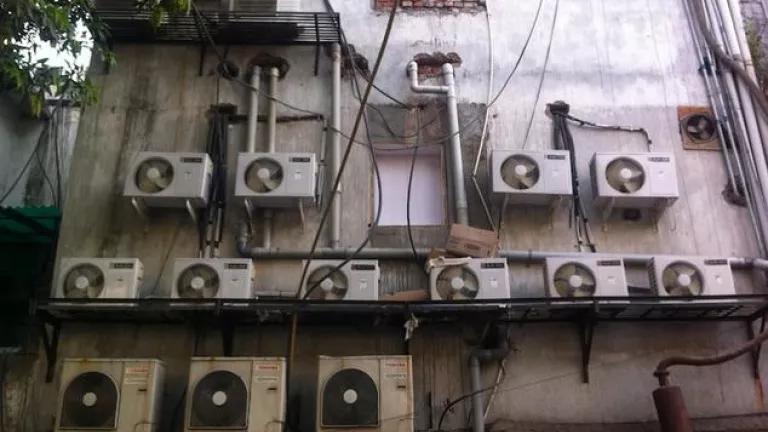Climate Action: Global Transition Away from HFCs

Co-Authored by Henry Ruehl, NRDC Energy Fellow
In India and the world, governments, businesses, and environmental groups continue to make steady progress toward phasing down the use of harmful climate-damaging hydrofluorocarbons (HFCs) in air conditioners, as shown in the recent Bangkok talks. While the recent decision of the DC Circuit Court to limit the Environmental Protection Agency’s regulations on HFCs may temporarily slow progress in the United States, governments and companies across India and around the world are moving forward in implementing the Kigali Amendment and ensuring that HFCs, like their ozone-depleting predecessors, become a thing of the past.
Recently, the U.S. Court of Appeals for the District of Columbia Circuit (one of the courts below the U.S. Supreme Court and the court that is charged with reviewing many EPA Clean Air Act rules) issued a divided decision to EPA’s efforts to cut emissions of HFCs in the United States. The case is called Mexichem Fluor, Inc. v. EPA.
Three important takeaways, as my colleague David Doniger highlights, are: First, this isn’t necessarily the last word from the courts and the ruling will likely be appealed. Second, the HFC phase down has broad industry, government and environmental support in the U.S.; many companies are moving forward with the transition to climate-friendly gases. Third, the D.C. Circuit decision says nothing about the Kigali Agreement. The United States ratification is pending with the President and the Senate, and despite President Trump’s withdrawal from the Paris Agreement, there is no change of policy on the Kigali Agreement.
HFCs are refrigerants commonly used in air conditioners that are used in cars, homes and offices, as well as other cooling systems. HFCs are incredibly potent greenhouse gases; their global warming potential (GWP) is thousands of times that of carbon dioxide. This means that emitting a kilogram of an HFC contributes to climate change as much as a ton or more of carbon dioxide.
While they only account for a small portion of greenhouse gas emissions now, HFCs are the fastest-growing class of greenhouse gases. The demand for cooling and air conditioning use is likely to skyrocket in India and other developing countries. However, chemical companies and manufacturers are working on replacing HFCs with more climate-friendly alternative refrigerants. The Kigali Amendment to the Montreal Protocol, agreed to by countries around the world last fall, has established targets and funding for countries to phase down and replace HFCs.
India was key in the Kigali Agreement, and it is moving forward in reducing HFCs now as part of the global transition under the Montreal Protocol. India will freeze HFC use at 2024 levels, starting reductions in 2028. Air conditioning companies in India are replacing the older refrigerant, R-22, which both harms the ozone layer and has high global warming potential, with either R-410A, R-32 or R-290, of which R-410A has the highest global warming potential (GWP).
Recently, six of India’s largest air conditioner manufacturers announced plans to leapfrog to the lower-GWP refrigerant HFC, R-32, instead of R-410A. The Indian market, like the European and Chinese markets, is also moving toward the hydrocarbon refrigerant R-290, which has the lowest GWP and is more energy efficient. Companies in India and researchers are actively working on expansion of R-290 use as the refrigerant can cause safety concerns when applied to larger charge sizes. Replacing R-22 with R-410A – the high global warming potential refrigerant that developed countries chose a decade ago when making their transition – would solve one problem by creating another. The move to leapfrog beyond R-410A to more climate-friendly and energy efficient refrigerants, such as R-32 and R-290, helps put India on track to reduce the global warming impact of refrigerants used in air conditioning under the Montreal Protocol.
Countries around the world are also making progress in phasing down HFCs. An international push is critical to combating climate change, since the benefits of the planned reduction in HFC use flowing from the Kigali Amendment are huge—up to half a degree reduction in the increase in global temperatures. This represents a significant contribution towards achieving the goal of the Paris Agreement to limit future warming below 1.5-2.0˚C. The Kigali Amendment is a major global climate success; it shows that nations can work together to curb climate change, and that people across the globe can have affordable, climate-friendly air conditioning. What is more, worldwide progress towards the goals of the Kigali Amendment is continuing unabated despite the seeming setback of the U.S. court decision.
In India, for example, the national government has plans to develop a National Cooling Action Plan. A primary focus worldwide is enabling manufacturers who are currently making a transition from the use of ozone-depleting HCFCs to “leapfrog” HFCs and move right to ozone-friendly, climate-friendly alternatives. NRDC and our partners have been interviewing dozens of manufacturers over the last year to help determine what would enable them to transition to cleaner technologies faster. Another significant area of progress is updating safety standards and codes; many alternatives to HFCs are climate-friendly but flammable, and product design standards will need to be improved to ensure safe use of these refrigerants. At the Bangkok Talks, representatives of international and national safety standards committees presented plans and timelines for updating standards accordingly.
Replacing HFCs with climate-friendly refrigerants is a crucial part of combating climate change. While the DC Circuit Court decision may slow immediate U.S. implementation, it is fortunate that companies, environmental groups, and governments in India and around the world continuing with a global phase down.
Note: This updated post includes discussion on R-290 and links to our earlier post on energy efficient and climate-friendly refrigerants.
